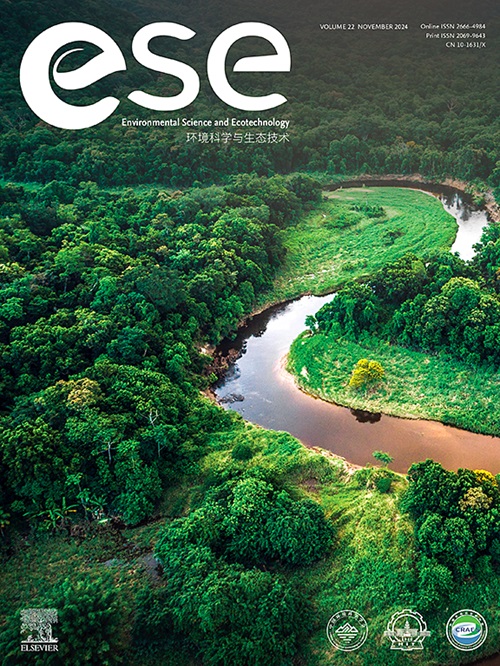全球抗生素热点和风险:同一个健康评估
IF 14
1区 环境科学与生态学
Q1 ENVIRONMENTAL SCIENCES
引用次数: 0
摘要
抗生素在全球环境中日益普遍,推动了抗菌素耐药性并破坏了微生物循环。这些影响对人类、动物和环境健康构成威胁。因此,解决这一紧急问题需要一个统一健康框架,该框架集成了这些相互关联的方面。在这里,我们系统地回顾了137种抗生素在不同的全球环境隔间。我们发现磺胺类药物、大环内酯类药物、喹诺酮类药物和四环素类药物在全球普遍存在,尤其是在亚洲和非洲,而β-内酰胺类药物在欧洲占主导地位。分层聚类揭示了10种优先的液相抗生素和8种迫切需要关注的固相抗生素。区域分析表明,美洲和非洲地表水的废水处理厂液体中抗生素浓度最高,亚洲和欧洲检测到的水平普遍较低。利用One Health评估框架,我们整合了与人类和动物健康相关的抗生素耐药性选择的预测无效应浓度(PNECRS)和影响微生物氮循环过程的最低抑制浓度(mic)。风险评估强调废水处理厂液体(平均超标20%)和动物粪便(平均超标44%)是最关键的隔间。非洲的总体风险最高,平均超过53%。值得注意的是,液相的环丙沙星和氧氟沙星,以及固相的恩诺沙星和诺氟沙星,成为对健康构成重大威胁的抗生素。这项研究促进了我们对抗生素全球分布的理解,为有针对性的干预措施提供了基础,以减轻人类、动物和环境卫生部门的抗生素相关风险。本文章由计算机程序翻译,如有差异,请以英文原文为准。

Global antibiotic hotspots and risks: A One Health assessment
Antibiotics are increasingly prevalent in global environments, driving antimicrobial resistance and disrupting microbial cycling. These impacts pose threats to human, animal, and environmental health. Therefore, addressing this emergent issue necessitates a One Health framework that integrates these interconnected dimensions. Here we systematically review 137 antibiotics across diverse global environmental compartments. We find that sulfonamides, macrolides, quinolones, and tetracyclines are globally ubiquitous, particularly prevalent in Asia and Africa, whereas β-lactams dominates in Europe. Hierarchical clustering revealed ten priority antibiotics in liquid phases and eight in solid phases requiring urgent attention. Regional analysis indicated the highest antibiotic concentrations within wastewater treatment plant liquids in the Americas and surface waters in Africa, with generally lower levels detected in Asia and Europe. Utilizing a One Health assessment framework, we integrated Predicted No-Effect Concentrations for antibiotic resistance selection (PNECRS) relevant to human and animal health with Minimum Inhibitory Concentrations (MICs) affecting microbial nitrogen cycling processes. Risk assessment highlighted wastewater treatment plant liquids (20 % average exceedance) and animal manure (44 % average exceedance) as the most critical compartments. Africa exhibited the highest overall risk, averaging a 53 % exceedance rate. Notably, ciprofloxacin and ofloxacin in liquid phases, as well as enrofloxacin and norfloxacin in solid phases, emerged as antibiotics posing significant One Health risks. This study advances our understanding of antibiotic distribution globally, offering a foundation for targeted interventions to mitigate antibiotic-related risks across human, animal, and environmental health sectors.
求助全文
通过发布文献求助,成功后即可免费获取论文全文。
去求助
来源期刊

Environmental Science and Ecotechnology
Multiple-
CiteScore
20.40
自引率
6.30%
发文量
11
审稿时长
18 days
期刊介绍:
Environmental Science & Ecotechnology (ESE) is an international, open-access journal publishing original research in environmental science, engineering, ecotechnology, and related fields. Authors publishing in ESE can immediately, permanently, and freely share their work. They have license options and retain copyright. Published by Elsevier, ESE is co-organized by the Chinese Society for Environmental Sciences, Harbin Institute of Technology, and the Chinese Research Academy of Environmental Sciences, under the supervision of the China Association for Science and Technology.
 求助内容:
求助内容: 应助结果提醒方式:
应助结果提醒方式:


